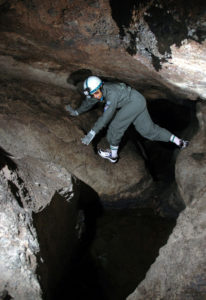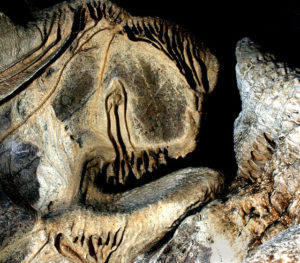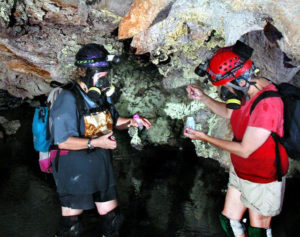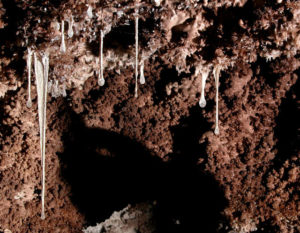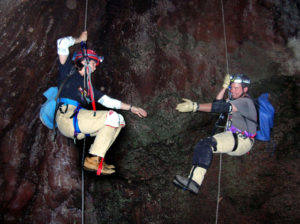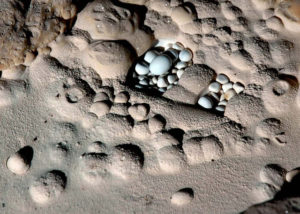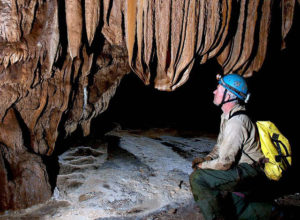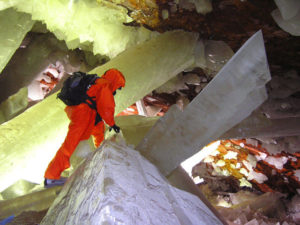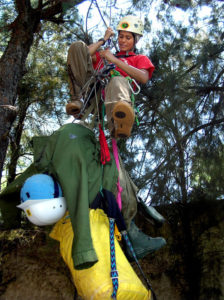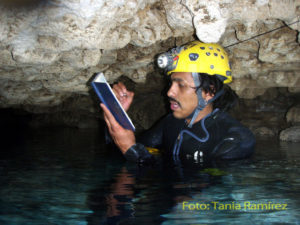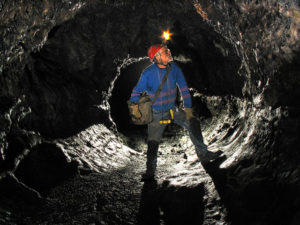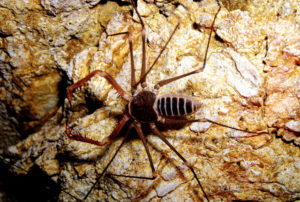Soaking wet and covered with mud, we followed the narrow underground stream deeper and deeper into the cave until we found ourselves standing about three meters above a pool of undetermined depth. The thick, dark liquid in the pool was composed of water, bat urine and guano, and a dead rat was floating on the surface. Jesús and I looked at each other. “There’s only one way to continue on,” I said. We stared down at the smelly pool which we later named El Pozo de la Pestilencia. “Ni modo,” replied Jesús — what else can we do?” And we both plunged in.
Why would anyone want to swim across such a pond or leap into a dark chasm whose bottom cannot be seen, in order to crawl in utter blackness through the very entrails of the earth? And why would hundreds of seemingly sane people travel all the way to Mexico from every corner of the planet just to disappear underground, far from the sunshine and beaches so sought after by other tourists?
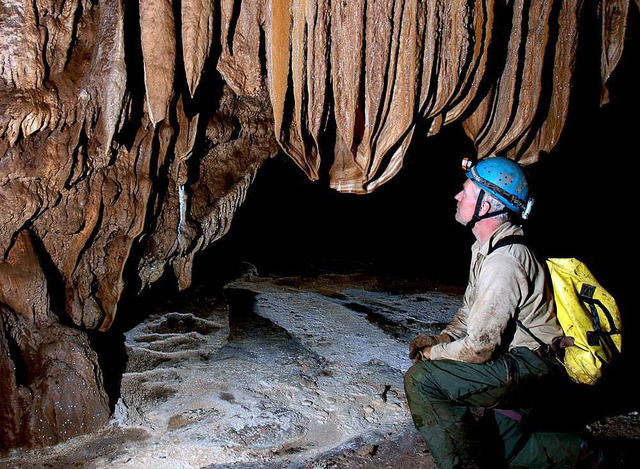
The answer lies deep within the human psyche. We are by nature explorers and we spend our lives exploring universes, beginning with the universe of our own bodies. Some people eventually stop exploring (and some would say, stop living) while others never cease searching for the unknown. As far as the surface of our planet goes, we’ve reached the point where it’s difficult to say, “I am the very first human being to stand in this spot,” but beneath our feet stretch vast labyrinths where we’re sure no one has ever gone before. This may not be the case in some European countries where speleology (the study of caves) has been popular for over a century, but in Mexico, underground exploration is fairly new: the number of known caves is too great to be counted and the potential for finding new ones is enormous. Every speleologist in Mexico has a very good chance of peering into a virgin cave passage with no idea what may be around the corner. Nothing is quite as exhilarating being the first person in history to step into an unknown realm.
Caves in Oaxaca
When it comes to big, long spectacular caves, Mexico has so much to offer that for years the world’s cavers have considered it their New Frontier. Seven of the fifty deepest caves on the planet are found here. Mexico’s deepest cave system is Sistema Cheve, in Oaxaca with a depth of 1,484 meters, the twelfth deepest cave in the world. Almost as deep is Sistema Huautla, also in Oaxaca, which (for the moment) bottoms out at 1,475 meters and is a whopping sixty-two kilometers in length. In extensive labyrinths like these, cave explorers are accustomed to spend a week or more underground, living, cooking and sleeping, usually under cold and wet conditions.
Precisely the opposite conditions are found in one of Mexico’s most famous caves, the Crystal Cave of Naica, home of the largest crystals the world has ever seen — some of which are eleven meters long and so wide you can’t get your arms around one. The cave is located in northern Mexico, southeast of Chihuahua, at a depth of 300 meters. It was discovered in 2000 when silver miners broke into it. Its air temperature of 50° C (122° F) and its humidity of 100% add up to a lethal combination for human beings. The Crystal Cave is one of very few places ever found which has been called — in the same breath — “the most beautiful place on earth” and “one step away from Hell.”
In order to discover Naica’s secrets, speleologists had to design special cooling suits that would allow them to spend more than a few minutes inside. One of their projects was the removal of tiny drops of water trapped deep inside one of the crystals. To their amazement, they discovered bacteria living inside this water, adding to the ever-growing proof that life can be found in the most inhospitable places on this planet and to suspicions that it will also be found on other celestial bodies, like Mars.
La Villa Luz: a bizarre cave in Tabasco
Another utterly bizarre Mexican cave is La Cueva de la Villa Luz, a river cave in the southern state of Tabasco. It’s a two-kilometer-long system of passages which smell like rotten eggs and which are teeming with life based on the oxidation of hydrogen sulfide, which bubbles up through the water, coloring it white and producing sulfuric acid. U.S. cave explorer Jim Pisarowicz first stepped into this unique cave in 1987 and was amazed at its curious geochemical features. Perhaps strangest of all were the rubbery “stalactites” hanging from the ceiling and dripping sulfuric acid. These, Pisarowicz called “snottites” and the name has stuck ever since.
The following year, Pisarowicz returned with friends to map the cave. He later reported, “This is the first time I had ever been in a cave where the survey crew mutinied because they were being burned by acid.” In 1998, Pisarowicz set up a new expedition with Dr. Louise Hose and a team of twenty specialists. This time all the speleologists wore face masks with acid-gas filters. Previous explorers had learned the hard way that prolonged exposure to hydrogen sulfide could cause nerve damage, loss of memory and even death. Their gas detectors, intended for measuring hydrogen sulfide concentration, “beeped alarmingly often,” says Hose, indicating that the concentration exceeded the acceptable level of 10 ppm.
One result of this expedition was a new insight into the manner in which caves are formed. Researchers Diana Northup and Penny Boston discovered that the cave’s snottites and other strange formations were brimming with bacteria closely related to Aciditheobacillus thiooxidans, a known sulfur-loving organism. It turned out that these microorganisms oxidize compounds like hydrogen sulfide, producing acid that dissolves the cave’s limestone walls and produces gypsum. Gypsum is soft and soluble and can easily be carried away by underground streams, eventually resulting in large, spectacular cave systems like Carlsbad Caverns.
While the Naica caves are extremely difficult to visit, Cueva de Villa Luz (also called Cueva de la Sardina by locals) is open to the public and is apparently not considered dangerous as long as you stick to the well-ventilated areas near the entrance. The cave is located inside a regional park called Kolem Jaa and may be visited during a day trip from Tabasco’s capital, Villahermosa.
Mexico’s cenotes and underwater caves
When it comes to long, deep or bizarre caves, Mexico is a world leader, but how about underwater caves? Well, guess where the longest explored underwater cave in the world is located? Yes, it just happens to be in Quintana Roo, Mexico. The cave system is called Ox Bel Ha (from Mayan, meaning “Three Paths of Water”) and is more than 180 kilometers long. The story of this cave’s exploration began in 1996 when four cave divers did a quick dive in a cenote called Las Canales. A cenote (from the Mayan word for “well”) is an opening (often round and dramatically beautiful) giving access to underground water, in the Yucatan Peninsula. Inside a cenote, divers typically find a layer of rainwater floating on top of a layer of salt water. The surface where these two layers meet is known as a halocline. When divers disturb it, the water turns blurry, adding yet another complication to an already hairy situation.
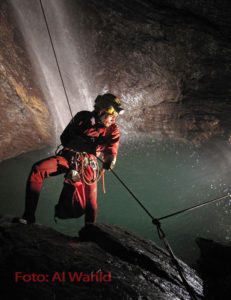
In 1998, two of the divers, Sam Meacham and Bil Phillips, returned to the area and visited another cenote called La Esmeralda. As they sat at its edge, admiring the view, Meacham’s pocket knife fell into the water, providing the pair with the perfect excuse to come back and dive La Esmeralda.
According to Grupo de Exploración Ox Bel Ha, the divers entered a cavern they later named The Mayan Skyway. “It was an inspiration; at its widest part, it spanned close to 100 feet; the ceiling to floor distance was 25-30 feet in some areas; fossils stuck out of the walls and littered the floor and a steady flow of fresh water could be seen skipping across the saltwater below. Side passages seemed to branch off in all directions… Decorations hung from the ceiling and reached up from the floor, frozen in time since they were formed many thousands of years before.” Over the years, the size of Ox Bel Ha has grown and grown and its entrances now include 130 cenotes. The benefits of the mapping of Ox Bel Ha to the geography, botany and biology of the Yucatan Peninsula are incalculable.
A word should be said about the brave souls who don artificial breathing equipment to penetrate the airless and lightless recesses of the earth. Theirs is, without a doubt, one of the most dangerous activities that human beings have ever undertaken on this planet. Every year the U.S. National Speleological Society publishes an analysis of all the caving accidents that have occurred in the Americas. The most recent report lists 50 incidents which resulted in various types of injuries or inconveniences and a total of 5 fatalities. When it comes to cave diving incidents, however, the number of incidents is 12 and the total number of deaths is 11. Cave divers, it seems, cannot afford to make a single mistake.
Watch out for histoplasmosis
All of the caves mentioned above are unusual and dangerous, to say the least, but even the most ordinary Mexican cave usually hosts a far more common and more subtle danger. A fungus called Histoplasma capsulatum typically grows on the guano underfoot and shoots microscopic spores into the air cavers breathe. The spores lodge in your lungs and after an incubation period of about eleven days, you may suddenly develop a hacking cough, chest pains and an intermittent fever. This is probably histoplasmosis and it is normally “cured” by resting for a week or so while your lungs encapsulate the spores. Some people experience much lighter symptoms while others may require hospitalization.
It is popularly thought that wearing a face mask can protect you from “histo.” Research, however, indicates that only masks which tightly adhere to the skin are effective. On one occasion, sixteen cave explorers, all wearing the ordinary sort of face masks (such as those used by nurses and paint sprayers) entered a particularly dusty cave. Eleven days later, every one of them had histoplasmosis. This occurred in the state of Jalisco, which local cavers call “The Histo Capital of the World.” Some years ago, researchers at the Guadalajara IMSS (Social Security Institute) were puzzled to find cases of histoplasmosis among workers digging a trench for the Electric Commission. They began to take soil samples from all over the state and discovered that histo spores can be found a meter below the surface in limestone areas, apparently deposited thousands of years ago by overflying bats. So you can occasionally enjoy the experience of histoplasmosis just by digging a hole!
Bad air
Another far less common danger encountered in Mexican caves is “bad air.” I first ran into this problem while rappelling into a narrow pit around 50 meters deep. About 2/3 of the way down, the carbide lamp on my helmet suddenly went out. I just figured the nozzle was plugged and kept on going right to the bottom. Here I disconnected from the rope and sat down on the ground. I was huffing and puffing like someone who had just ruin a marathon and foolishly attributed this to being “in bad shape” until suddenly I remembered an interview I had done with bat expert Merlyn Tuttle, in which he described the typical symptoms of asphyxiation by carbon dioxide. I immediately realized I was standing at the bottom of an invisible lake of CO? and I recalled that Tuttle had said that in such a situation, a person will pass out in less than two minutes.
The first thing I did was grab my whistle in order to signal the next caver not to come down. Three blasts are supposed to indicate trouble, but with almost no air to breathe down there, my “blasts” sounded more like burps and it’s a miracle the cavers up above heard me at all. Next, I had to switch over from descending to ascending equipment and I think I broke all the world’s records for doing this because I knew I had only seconds left to get out of there.
I began to go up the rope and I recognized exactly the moment when my head rose out of that invisible lake of unbreathable gas. It was like emerging from water. I could suddenly take in great gulps of “real air” and I was overwhelmed with happiness and relief: I was going to live!
After that nearly fatal experience, my friends and I made it a habit to do every rappel with all of our ascending gear already connected and ready to use. We also began to carry small disposable lighters in our cave packs. You know there’s not enough oxygen if you see the flame “floating” an inch or so above the lighter.
Most caves in Mexico are found in limestone and often display magnificent stalactites, stalagmites and other formations like draperies, shields and gravity-defying helictites. These almost always enthrall cave visitors and make all the dangers and inconveniences of exploration well worth the effort.
Mexico’s dramatic lava caves
Besides great numbers of limestone caverns, Mexico also has many lava-tube caves. These are formed when the surface of a river of lava begins to cool. The molten rock flows out from underneath, often leaving a smooth-walled tunnel that could be many kilometers in length. Lava caves may be decorated with bizarrely shaped stalactites and stalagmites caused by lava dripping from the ceiling. Explorers can also find lava falls and lava balls. The latter are boulders caught up in the flowing lava and eventually “glued” to the floor or even to the ceiling. The area south of Mexico City abounds with an extensive maze of lava tubes whose rough surface is famed for shredding the shirts and pants of cavers dedicated to mapping and photographing them.
It may take nature millennia to produce a stunningly beautiful cave formation, but it takes a human being only a split second to break it off. Many Mexican caves have been irreversibly trashed by people who have never reflected on this fact. Likewise, countless beneficial bats have been killed by people who mistakenly believe “all bats are vampires.” In reality, most bats either eat tones of insects nightly or pollinate a wide range of important plants, from bananas to the agaves from which tequila is made. See Bat Conservation International for more information.
My experience shows that a five-minute chat can change these enemies of caves into friends and I urge anyone who has a chance, to spread the word. The Golden Rule of cave explorers worldwide is: take nothing but pictures; leave nothing but footprints; kill nothing but time.
News in English about Mexican caves is published in bulletins of the Association for Mexican Cave Studies. The best book on Mexican caves I’ve seen is Un Viaje al Mexico Profundo (A Voyage to Deepest Mexico) by Gustavo Vela Turcott, in Spanish, published in 2005 by Editorial Santillana, Mexico City, ISBN: 970-29-1272-5. It has 180 pages in color and 200 photos. Available directly from the author.

